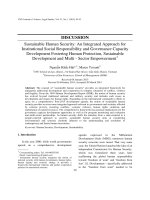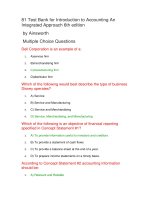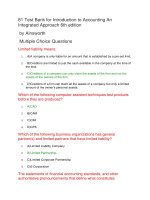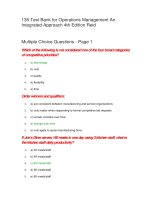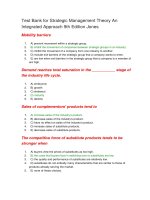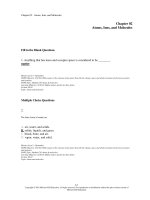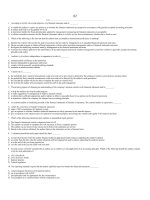Human physiology an integrated approach 6th edition dee unglaub silverthorn test bank
Bạn đang xem bản rút gọn của tài liệu. Xem và tải ngay bản đầy đủ của tài liệu tại đây (119.4 KB, 34 trang )
Human Physiology: An Integrated Approach, 6e (Silverthorn)
Chapter 2 Molecular Interactions
1) Stanley Miller set out to demonstrate an explanation for the origins of organic molecules using a
combination of simple organic molecules, heat and periodic burst of electricity through the mixture,
ultimately producing what kind of molecules?
A) carbohydrates
B) amino acids
C) lipids
D) glycoproteins
E) nucleic acids
Answer: B
Section Title: Molecules and Bonds
Learning Outcome: 2.1
Skill: Level I: Reviewing Facts and Terms (Bloom's Taxonomy: Comprehension)
2) Glycosylated molecules are those formed with which group of organic compounds?
A) lipids
B) nucleic acids
C) proteins
D) carbohydrates
E) lipoproteins
Answer: D
Section Title: Molecules and Bonds
Learning Outcome: 2.1
Skill: Level I: Reviewing Facts and Terms (Bloom's Taxonomy: Knowledge)
3) Cells regulate their level of activity by regulating the amount of proteins present in the cell at any
given time, so an up regulation of enzymes would be expected to
A) increase the level of productivity of chemical reactions that rely on them.
B) decrease the level of productivity of chemical reactions that rely on them.
C) increase the rate of reactions catalyzed by the enzymes.
D) decrease the rate of reactions catalyzed by the enzymes.
E) both decrease the level of productivity of chemical reactions that rely on them and decrease the rate
of reactions catalyzed by the enzymes.
Answer: A
Section Title: Protein Interactions
Learning Outcome: 2.10
Skill: Level I: Reviewing Facts and Terms (Bloom's Taxonomy: Comprehension)
1
Copyright (c) 2013 Pearson Education, Inc.
4) When an enzyme reaches its saturation point,
A) the amount of substrate for the enzyme to act upon is very high.
B) the amount of substrate for the enzyme to act upon is very low.
C) the amount of product produced continues to increase.
D) the amount of product produced by the enzyme decreases.
E) the amount of substrate for the enzyme to act upon is very low and the amount of product produced
by the enzyme decreases.
Answer: A
Section Title: Protein Interactions
Learning Outcome: 2.9
Skill: Level I: Reviewing Facts and Terms (Bloom's Taxonomy: Comprehension)
5) Which group of elements makes up more than 90% of the body's mass?
A) O, H, Na
B) C, Na, K
C) O, Ca, H
D) Ca, C, O
E) O, C, H
Answer: E
Section Title: Molecules and Bonds
Learning Outcome: 2.1
Skill: Level I: Reviewing Facts and Terms (Bloom's Taxonomy: Comprehension)
6) The organic molecules known as phospholipids are key components of cell membranes and composed
of what monomeric units?
A) amino acids
B) nucleotides
C) glycerol
D) fatty acids
E) both glycerol and fatty acids
Answer: E
Section Title: Molecules and Bonds
Learning Outcome: 2.1
Skill: Level I: Reviewing Facts and Terms (Bloom's Taxonomy: Knowledge)
7) Chromium is
A) a major essential element.
B) a minor essential element.
C) a dietary supplement with no natural role in the body.
D) None of the answers are correct.
Answer: D
Section Title: Running Problem
Learning Outcome: 2.1
Skill: Level I: Reviewing Facts and Terms (Bloom's Taxonomy: Comprehension)
2
Copyright (c) 2013 Pearson Education, Inc.
8) Which of the following is a way to recognize a carbohydrate by looking at its name only?
A) It always ends in -ase.
B) It ends in -ose
C) It begins with nucleo-.
D) It begins with proteo-.
E) It begins with lipo-.
Answer: B
Section Title: Molecules and Bonds
Learning Outcome: 2.1
Skill: Level I: Reviewing Facts and Terms (Bloom's Taxonomy: Comprehension)
9) Which of the following is NOT considered an essential element for a living organism?
A) carbon
B) hydrogen
C) mercury
D) oxygen
E) nitrogen
Answer: C
Section Title: Molecules and Bonds
Learning Outcome: 2.1
Skill: Level I: Reviewing Facts and Terms (Bloom's Taxonomy: Knowledge)
10) The largest carbohydrate molecules are called polysaccharides because they are composed of
________ molecules bonded together with one another.
A) amino acid
B) nucleotide
C) purine
D) pyrimidine
E) sugar
Answer: E
Section Title: Molecules and Bonds
Learning Outcome: 2.1
Skill: Level I: Reviewing Facts and Terms (Bloom's Taxonomy: Knowledge)
11) Essential amino acids that are used to build proteins
A) exist in twenty six different configurations.
B) are linked together by ionic chemical bonds in proteins.
C) can be used medically for both diagnosis and treatment of diseases.
D) can be derived from the foods we eat and digest.
E) can only be made by cells within our bodies.
Answer: E
Section Title: Molecules and Bonds
Learning Outcome: 2.1
Skill: Level I: Reviewing Facts and Terms (Bloom's Taxonomy: Comprehension)
3
Copyright (c) 2013 Pearson Education, Inc.
12) Which of the following are examples of cations?
A) SO42B) Ca2+
C) HPO42D) HCO3E) ClAnswer: B
Section Title: Molecules and Bonds
Learning Outcome: 2.1
Skill: Level I: Reviewing Facts and Terms (Bloom's Taxonomy: Comprehension)
13) A positively charged ion is called a(n)
A) electron.
B) proton.
C) neutron.
D) cation.
E) anion.
Answer: D
Section Title: Molecules and Bonds
Learning Outcome: 2.2
Skill: Level I: Reviewing Facts and Terms (Bloom's Taxonomy: Comprehension)
14) The most important polar molecule is ________ because it is practically a universal solvent.
A) water
B) bicarbonate
C) sodium chloride
D) magnesium sulfate
E) nucleic acid
Answer: A
Section Title: Molecules and Bonds
Learning Outcome: 2.4
Skill: Level I: Reviewing Facts and Terms (Bloom's Taxonomy: Comprehension)
15) A molecule referred to as highly soluble is
A) very likely to dissolve in water.
B) not very likely to dissolve in water.
C) called aqueous.
D) very likely to dissolve in water and is called aqueous.
E) not very likely to dissolve in water and is called aqueous.
Answer: D
Section Title: Noncovalent Interactions
Learning Outcome: 2.4
Skill: Level I: Reviewing Facts and Terms (Bloom's Taxonomy: Comprehension)
4
Copyright (c) 2013 Pearson Education, Inc.
16) A free radical is a
A) charged particle.
B) molecule with an extra electron.
C) molecule with an extra neutron.
D) molecule with an extra proton.
E) molecule with an unpaired electron.
Answer: E
Section Title: Molecules and Bonds
Learning Outcome: 2.2
Skill: Level I: Reviewing Facts and Terms (Bloom's Taxonomy: Comprehension)
17) The chemical bonding behavior of an atom is directly determined by
A) the number of protons.
B) the number of neutrons.
C) the number and arrangement of electrons.
D) the size of the atom.
E) the mass of the atom.
Answer: C
Section Title: Molecules and Bonds
Learning Outcome: 2.2
Skill: Level I: Reviewing Facts and Terms (Bloom's Taxonomy: Comprehension)
18) Atoms in a covalent molecule
A) share electrons in single pairs.
B) share electrons in double pairs.
C) share electrons in triple pairs.
D) share electrons singly, never in pairs.
E) can share electrons in single pairs, double pairs, or triple pairs.
Answer: E
Section Title: Molecules and Bonds
Learning Outcome: 2.3
Skill: Level I: Reviewing Facts and Terms (Bloom's Taxonomy: Comprehension)
19) The weak interactions between atoms that keep atoms near each other but don't tightly bind them
together are called
A) hydrogen bonds.
B) van der Waals forces.
C) ionic bonds.
D) hydrogen bonds and van der Waals forces.
E) van der Waals forces and ionic bonds.
Answer: D
Section Title: Molecules and Bonds
Learning Outcome: 2.3
Skill: Level I: Reviewing Facts and Terms (Bloom's Taxonomy: Comprehension)
5
Copyright (c) 2013 Pearson Education, Inc.
20) All of these statements about carbohydrates are true except one. Identify the exception.
A) Simple sugars include lactose, glucose, and ribose.
B) Cellulose is the most abundant carbohydrate on earth.
C) Glycogen is a storage polysaccharide made by animal cells.
D) Polysaccharides are important both for energy storage and to provide structure to cells.
E) Glycogen is important both for energy storage and to provide structure for cells.
Answer: E
Section Title: Molecules and Bonds
Learning Outcome: 2.1
Skill: Level I: Reviewing Facts and Terms (Bloom's Taxonomy: Comprehension)
21) In regard to lipids, the term unsaturated refers to
A) the lack of double bonds between adjacent carbon atoms in a fatty acid.
B) the presence of double bonds between adjacent carbon atoms in a fatty acid.
C) the ring structure of steroids.
D) glycerol, which acts as an anchor for joined fatty acids.
E) fats, such as butter and lard, which come from animal sources.
Answer: B
Section Title: Molecules and Bonds
Learning Outcome: 2.1
Skill: Level I: Reviewing Facts and Terms (Bloom's Taxonomy: Comprehension)
22) Each amino acid differs from others in the
A) number of central carbon atoms.
B) size of the amino group.
C) number of carboxyl groups.
D) chemical structure of the R group.
E) number of peptide bonds in the molecule.
Answer: D
Section Title: Molecules and Bonds
Learning Outcome: 2.1
Skill: Level I: Reviewing Facts and Terms (Bloom's Taxonomy: Comprehension)
23) The alpha-helix and pleated sheet are examples of the ________ structure of a protein.
A) primary
B) secondary
C) tertiary
D) quaternary
E) pentanary
Answer: B
Section Title: Noncovalent Interactions
Learning Outcome: 2.6
Skill: Level I: Reviewing Facts and Terms (Bloom's Taxonomy: Comprehension)
6
Copyright (c) 2013 Pearson Education, Inc.
24) Interactions between different globular or fibrous polypeptide chains result in which type of
structure?
A) primary
B) secondary
C) tertiary
D) quaternary
E) pentagonal
Answer: D
Section Title: Noncovalent Interactions
Learning Outcome: 2.6
Skill: Level I: Reviewing Facts and Terms (Bloom's Taxonomy: Comprehension)
25) The concentration of a solution expresses the amount of
A) solvent per volume of solute.
B) solute per volume of solvent.
C) solvent per volume of solution.
D) solute per volume of solution.
E) None of the answers are correct.
Answer: D
Section Title: Noncovalent Interactions
Learning Outcome: 2.5
Skill: Level I: Reviewing Facts and Terms (Bloom's Taxonomy: Knowledge)
26) Nucleic acids are polymers of units called
A) amino acids.
B) fatty acids.
C) bases.
D) ribose.
E) nucleotides.
Answer: E
Section Title: Molecules and Bonds
Learning Outcome: 2.1
Skill: Level I: Reviewing Facts and Terms (Bloom's Taxonomy: Comprehension)
27) A nucleotide consists of a
A) five-carbon sugar and phosphate group.
B) five-carbon sugar and a nitrogenous base.
C) phosphate group and a nitrogenous base.
D) five-carbon sugar, a nitrogenous base, and a phosphate group.
E) five-carbon sugar and an amino acid.
Answer: D
Section Title: Molecules and Bonds
Learning Outcome: 2.1
Skill: Level I: Reviewing Facts and Terms (Bloom's Taxonomy: Knowledge)
7
Copyright (c) 2013 Pearson Education, Inc.
28) According to the rules of complementary base pairing, a nucleotide containing the base cytosine
would only pair with a nucleotide containing the base
A) thymine.
B) adenine.
C) uracil.
D) cytosine.
E) guanine.
Answer: E
Section Title: Molecules and Bonds
Learning Outcome: 2.1
Skill: Level I: Reviewing Facts and Terms (Bloom's Taxonomy: Knowledge)
29) The most important energy-transferring compound in cells is a nucleotide known as
A) glucose.
B) fructose.
C) protein.
D) adenosine triphosphate.
E) deoxyribonucleic acid.
Answer: D
Section Title: Molecules and Bonds
Learning Outcome: 2.1
Skill: Level I: Reviewing Facts and Terms (Bloom's Taxonomy: Knowledge)
30) Which bases below are purines?
1. adenine
2. cytosine
3. guanine
4. thymine
5. uracil
A) 1 and 2
B) 2 and 3
C) 1, 3, and 5
D) 1 and 3
E) 2, 4, and 5
Answer: D
Section Title: Molecules and Bonds
Learning Outcome: 2.1
Skill: Level I: Reviewing Facts and Terms (Bloom's Taxonomy: Comprehension)
31) Polymers are a typical formation of ________ molecules.
A) organic
B) inorganic
C) either organic or inorganic
Answer: A
Section Title: Molecules and Bonds
Learning Outcome: 2.1
Skill: Level I: Reviewing Facts and Terms (Bloom's Taxonomy: Comprehension)
8
Copyright (c) 2013 Pearson Education, Inc.
32) Cholesterol is
A) a precursor to steroid hormones.
B) a structural component of cell membranes.
C) a dangerous fat that is absent from a healthy body.
D) a precursor to steroid hormones and a structural component of cell membranes.
E) a precursor to steroid hormones, a structural component of cell membranes, and a dangerous fat that
is absent from a healthy body.
Answer: D
Section Title: Molecules and Bonds
Learning Outcome: 2.1
Skill: Level I: Reviewing Facts and Terms (Bloom's Taxonomy: Comprehension)
33) A component of an important buffer in the human body is
A) NaCl.
B) H+.
C) HCl.
D) HCO3-.
E) H2O.
Answer: D
Section Title: Noncovalent Interactions
Learning Outcome: 2.7
Skill: Level I: Reviewing Facts and Terms (Bloom's Taxonomy: Comprehension)
34) Which of the following substances is most alkaline?
A) lemon juice, pH = 2
B) urine, pH = 6
C) tomato juice, pH = 4
D) white wine, pH = 3
E) stomach secretions, pH = 1
Answer: B
Section Title: Noncovalent Interactions
Learning Outcome: 2.7
Skill: Level I: Reviewing Facts and Terms (Bloom's Taxonomy: Comprehension)
35) If a substance has a pH that is less than 7, it is considered
A) neutral.
B) acidic.
C) alkaline.
D) a buffer.
E) a salt.
Answer: B
Section Title: Noncovalent Interactions
Learning Outcome: 2.7
Skill: Level I: Reviewing Facts and Terms (Bloom's Taxonomy: Comprehension)
9
Copyright (c) 2013 Pearson Education, Inc.
36) Protein specificity is
A) the activation of a specific protein that is needed to perform a particular function.
B) the degree to which a protein is attracted to a ligand.
C) the ability of a protein to bind a certain ligand or a group of related ligands.
D) the degree to which a protein-ligand complex initiates a response.
E) the degree to which a protein is attracted to a ligand and the ability of a protein to bind a certain
ligand or a group of related ligands.
Answer: C
Section Title: Protein Interactions
Learning Outcome: 2.9
Skill: Level I: Reviewing Facts and Terms (Bloom's Taxonomy: Comprehension)
37) Which of the following is a common feature of soluble proteins?
A) structural support
B) noncovalent interaction
C) receptor binding
D) chemical modulation
E) All of the answers are correct.
Answer: B
Section Title: Protein Interactions
Learning Outcome: 2.6
Skill: Level I: Reviewing Facts and Terms (Bloom's Taxonomy: Comprehension)
Match the correct subatomic particle with the statement about it. Answers may be used once, more than
once, or not at all.
A. proton(s)
B. neutron(s)
C. electron(s)
38) An ion has gained or lost ________.
Answer: C
Section Title: Molecules and Bonds
Learning Outcome: 2.2
Skill: Level I: Reviewing Facts and Terms (Bloom's Taxonomy: Knowledge)
39) Isotopes of the same element differ by having different numbers of ________.
Answer: B
Section Title: Molecules and Bonds
Learning Outcome: 2.1
Skill: Level I: Reviewing Facts and Terms (Bloom's Taxonomy: Comprehension)
40) The identity of an element can be determined by the number of ________.
Answer: A
Section Title: Molecules and Bonds
Learning Outcome: 2.1
Skill: Level I: Reviewing Facts and Terms (Bloom's Taxonomy: Comprehension)
10
Copyright (c) 2013 Pearson Education, Inc.
41) This particle has a charge of +1 and a mass of 1.
Answer: A
Section Title: Molecules and Bonds
Learning Outcome: 2.1
Skill: Level I: Reviewing Facts and Terms (Bloom's Taxonomy: Comprehension)
42) This particle has a charge of -1 and a negligible mass.
Answer: C
Section Title: Molecules and Bonds
Learning Outcome: 2.1
Skill: Level I: Reviewing Facts and Terms (Bloom's Taxonomy: Comprehension)
43) This particle has a neutral charge and a mass of 1.
Answer: B
Section Title: Molecules and Bonds
Learning Outcome: 2.1
Skill: Level I: Reviewing Facts and Terms (Bloom's Taxonomy: Comprehension)
Match the symbol with the correct element:
A. P
B. Na
C. Ca
D. C
E. K
F. Pb
44) calcium
Answer: C
Section Title: Molecules and Bonds
Learning Outcome: 2.1
Skill: Level I: Reviewing Facts and Terms (Bloom's Taxonomy: Knowledge)
45) carbon
Answer: D
Section Title: Molecules and Bonds
Learning Outcome: 2.1
Skill: Level I: Reviewing Facts and Terms (Bloom's Taxonomy: Knowledge)
46) potassium
Answer: E
Section Title: Molecules and Bonds
Learning Outcome: 2.1
Skill: Level I: Reviewing Facts and Terms (Bloom's Taxonomy: Knowledge)
11
Copyright (c) 2013 Pearson Education, Inc.
47) phosphorus
Answer: A
Section Title: Molecules and Bonds
Learning Outcome: 2.1
Skill: Level I: Reviewing Facts and Terms (Bloom's Taxonomy: Knowledge)
48) lead
Answer: F
Section Title: Molecules and Bonds
Learning Outcome: 2.1
Skill: Level I: Reviewing Facts and Terms (Bloom's Taxonomy: Comprehension)
49) sodium
Answer: B
Section Title: Molecules and Bonds
Learning Outcome: 2.1
Skill: Level I: Reviewing Facts and Terms (Bloom's Taxonomy: Comprehension)
Identify each of the following as an element (A) or a compound (B).
50) CO2
Answer: B
Section Title: Molecules and Bonds
Learning Outcome: 2.1
Skill: Level I: Reviewing Facts and Terms (Bloom's Taxonomy: Comprehension)
51) C
Answer: A
Section Title: Molecules and Bonds
Learning Outcome: 2.1
Skill: Level I: Reviewing Facts and Terms (Bloom's Taxonomy: Comprehension)
52) O2
Answer: A
Section Title: Molecules and Bonds
Learning Outcome: 2.1
Skill: Level I: Reviewing Facts and Terms (Bloom's Taxonomy: Comprehension)
12
Copyright (c) 2013 Pearson Education, Inc.
Match each bond type with its description.
A. van der Waals
B. ionic
C. hydrogen
D. covalent
53) This results when an atom has such a strong attraction for electrons that it pulls one or more
electrons completely away from another atom.
Answer: B
Section Title: Molecules and Bonds
Learning Outcome: 2.3
Skill: Level I: Reviewing Facts and Terms (Bloom's Taxonomy: Comprehension)
54) These are weak attractive forces between hydrogen and certain other atoms.
Answer: C
Section Title: Molecules and Bonds
Learning Outcome: 2.3
Skill: Level I: Reviewing Facts and Terms (Bloom's Taxonomy: Comprehension)
55) These result when two atoms share a pair of electrons.
Answer: D
Section Title: Molecules and Bonds
Learning Outcome: 2.3
Skill: Level I: Reviewing Facts and Terms (Bloom's Taxonomy: Comprehension)
56) These are weak attractive forces between the nucleus of one atom and the electrons of another atom
close by.
Answer: A
Section Title: Molecules and Bonds
Learning Outcome: 2.3
Skill: Level I: Reviewing Facts and Terms (Bloom's Taxonomy: Comprehension)
13
Copyright (c) 2013 Pearson Education, Inc.
Match each class of biomolecules to the correct statement about it.
A. carbohydrates
B. lipids
C. proteins
D. nucleotides
57) Glucose and ribose are examples; these molecules provide energy or structure.
Answer: A
Section Title: Molecules and Bonds
Learning Outcome: 2.1
Skill: Level I: Reviewing Facts and Terms (Bloom's Taxonomy: Comprehension)
58) ATP and DNA are examples; they transfer energy and encode genetic information.
Answer: D
Section Title: Molecules and Bonds
Learning Outcome: 2.1
Skill: Level I: Reviewing Facts and Terms (Bloom's Taxonomy: Comprehension)
59) Composed of units called amino acids, these can be linked into chains over 100 peptides long.
Answer: C
Section Title: Molecules and Bonds
Learning Outcome: 2.1
Skill: Level I: Reviewing Facts and Terms (Bloom's Taxonomy: Comprehension)
60) Triglycerides and steroids are members of this group. As a class they are hydrophobic.
Answer: B
Section Title: Molecules and Bonds
Learning Outcome: 2.1
Skill: Level I: Reviewing Facts and Terms (Bloom's Taxonomy: Comprehension)
14
Copyright (c) 2013 Pearson Education, Inc.
Match each level of protein structure with its description.
A. primary
B. secondary
C. tertiary
D. quaternary
61) applies to proteins containing more than one peptide chain
Answer: D
Section Title: Protein Interactions
Learning Outcome: 2.8
Skill: Level I: Reviewing Facts and Terms (Bloom's Taxonomy: Comprehension)
62) the sequence and number of amino acids in the chain
Answer: A
Section Title: Protein Interactions
Learning Outcome: 2.8
Skill: Level I: Reviewing Facts and Terms (Bloom's Taxonomy: Comprehension)
63) the three-dimensional shape of an amino acid chain; can be fibrous or globular
Answer: C
Section Title: Protein Interactions
Learning Outcome: 2.8
Skill: Level I: Reviewing Facts and Terms (Bloom's Taxonomy: Comprehension)
64) the spatial arrangement of amino acids; can be a helix or a pleated sheet
Answer: B
Section Title: Protein Interactions
Learning Outcome: 2.8
Skill: Level I: Reviewing Facts and Terms (Bloom's Taxonomy: Comprehension)
15
Copyright (c) 2013 Pearson Education, Inc.
Match the descriptions to the correct protein category.
A. fibrous
B. globular
65) soluble in water
Answer: B
Section Title: Protein Interactions
Learning Outcome: 2.8
Skill: Level I: Reviewing Facts and Terms (Bloom's Taxonomy: Comprehension)
66) keratin
Answer: A
Section Title: Protein Interactions
Learning Outcome: 2.8
Skill: Level I: Reviewing Facts and Terms (Bloom's Taxonomy: Comprehension)
67) disulfide bond
Answer: B
Section Title: Protein Interactions
Learning Outcome: 2.8
Skill: Level I: Reviewing Facts and Terms (Bloom's Taxonomy: Comprehension)
68) lipid carriers
Answer: B
Section Title: Protein Interactions
Learning Outcome: 2.8
Skill: Level I: Reviewing Facts and Terms (Bloom's Taxonomy: Comprehension)
69) structural components
Answer: A
Section Title: Protein Interactions
Learning Outcome: 2.8
Skill: Level I: Reviewing Facts and Terms (Bloom's Taxonomy: Comprehension)
16
Copyright (c) 2013 Pearson Education, Inc.
For the following questions, match the type of modulator with the best description below.
A. involved in phosphorylation
B. cannot be displaced by competition
C. bind to proteins away from the active site
D. reversible antagonist
70) irreversible antagonist
Answer: B
Section Title: Protein Interactions
Learning Outcome: 2.10
Skill: Level I: Reviewing Facts and Terms (Bloom's Taxonomy: Comprehension)
71) covalent modulator
Answer: A
Section Title: Protein Interactions
Learning Outcome: 2.10
Skill: Level I: Reviewing Facts and Terms (Bloom's Taxonomy: Comprehension)
72) competitive inhibitor
Answer: D
Section Title: Protein Interactions
Learning Outcome: 2.10
Skill: Level I: Reviewing Facts and Terms (Bloom's Taxonomy: Comprehension)
73) allosteric modulator
Answer: C
Section Title: Protein Interactions
Learning Outcome: 2.10
Skill: Level I: Reviewing Facts and Terms (Bloom's Taxonomy: Comprehension)
74) The smallest unit of an element is a(n) ________.
Answer: atom
Section Title: Molecules and Bonds
Learning Outcome: 2.1
Skill: Level I: Reviewing Facts and Terms (Bloom's Taxonomy: Knowledge)
75) When two or more atoms are chemically linked, the smallest unit of the resulting material is referred
to as a(n) ________.
Answer: molecule
Section Title: Molecules and Bonds
Learning Outcome: 2.1
Skill: Level I: Reviewing Facts and Terms (Bloom's Taxonomy: Knowledge)
76) A(n) ________ is a substance that consists entirely of atoms with the same atomic number.
Answer: element
Section Title: Molecules and Bonds
Learning Outcome: 2.1
Skill: Level I: Reviewing Facts and Terms (Bloom's Taxonomy: Knowledge)
17
Copyright (c) 2013 Pearson Education, Inc.
77) The center of an atom is called the ________.
Answer: nucleus
Section Title: Molecules and Bonds
Learning Outcome: 2.1
Skill: Level I: Reviewing Facts and Terms (Bloom's Taxonomy: Knowledge)
78) Electrons travel around the center of the atom at high speed forming a(n) ________.
Answer: shell (or orbital)
Section Title: Molecules and Bonds
Learning Outcome: 2.2
Skill: Level I: Reviewing Facts and Terms (Bloom's Taxonomy: Comprehension)
79) A combination of two or more atoms that has physical and chemical properties that differ from the
atoms that compose it is called a(n) ________.
Answer: compound
Section Title: Molecules and Bonds
Learning Outcome: 2.1
Skill: Level I: Reviewing Facts and Terms (Bloom's Taxonomy: Comprehension)
80) Ions with a positive charge are called ________.
Answer: cations
Section Title: Molecules and Bonds
Learning Outcome: 2.1
Skill: Level I: Reviewing Facts and Terms (Bloom's Taxonomy: Knowledge)
81) Ions with a negative charge are called ________.
Answer: anions
Section Title: Molecules and Bonds
Learning Outcome: 2.1
Skill: Level I: Reviewing Facts and Terms (Bloom's Taxonomy: Knowledge)
82) A(n) ________ is a homogeneous mixture containing a solvent and a solute.
Answer: solution
Section Title: Noncovalent Interactions
Learning Outcome: 2.5
Skill: Level I: Reviewing Facts and Terms (Bloom's Taxonomy: Knowledge)
83) Molecules that readily dissolve in water are called ________.
Answer: hydrophilic (most are also polar)
Section Title: Noncovalent Interactions
Learning Outcome: 2.5
Skill: Level I: Reviewing Facts and Terms (Bloom's Taxonomy: Knowledge)
84) Molecules that do not dissolve in water are called ________.
Answer: hydrophobic (most are also nonpolar)
Section Title: Noncovalent Interactions
Learning Outcome: 2.5
Skill: Level I: Reviewing Facts and Terms (Bloom's Taxonomy: Knowledge)
18
Copyright (c) 2013 Pearson Education, Inc.
85) ________ is any molecule that binds to another molecule.
Answer: Ligand
Section Title: Protein Interactions
Learning Outcome: 2.9
Skill: Level I: Reviewing Facts and Terms (Bloom's Taxonomy: Knowledge)
86) Two methods of protein activation include ________ and ________.
Answer: proteolytic (removal of portions of the molecule), cofactor binding
Section Title: Protein Interactions
Learning Outcome: 2.8
Skill: Level I: Reviewing Facts and Terms (Bloom's Taxonomy: Comprehension)
87) The molecule DNA contains the five-carbon sugar ________.
Answer: deoxyribose
Section Title: Molecules and Bonds
Learning Outcome: 2.1
Skill: Level I: Reviewing Facts and Terms (Bloom's Taxonomy: Knowledge)
88) The molecule RNA contains the five-carbon sugar ________.
Answer: ribose
Section Title: Molecules and Bonds
Learning Outcome: 2.1
Skill: Level I: Reviewing Facts and Terms (Bloom's Taxonomy: Knowledge)
89) The purines found in DNA are ________ and ________.
Answer: adenine, guanine
Section Title: Molecules and Bonds
Learning Outcome: 2.1
Skill: Level I: Reviewing Facts and Terms (Bloom's Taxonomy: Knowledge)
90) The pyrimidines found in DNA are ________ and ________.
Answer: thymine, cytosine
Section Title: Molecules and Bonds
Learning Outcome: 2.1
Skill: Level I: Reviewing Facts and Terms (Bloom's Taxonomy: Knowledge)
91) In a chemical reaction, ________ between atoms are broken as atoms are rearranged in new
combinations to form different chemical substances.
Answer: chemical bonds
Section Title: Molecules and Bonds
Learning Outcome: 2.3
Skill: Level I: Reviewing Facts and Terms (Bloom's Taxonomy: Knowledge)
19
Copyright (c) 2013 Pearson Education, Inc.
92) The reaction rates of many chemical reactions that occur in the body are controlled by special
protein molecules called ________.
Answer: enzymes
Section Title: Protein Interactions
Learning Outcome: 2.10
Skill: Level I: Reviewing Facts and Terms (Bloom's Taxonomy: Knowledge)
93) List the following in order of increasing mass: atom, molecule, proton, neutron, electron.
Answer: electron < proton = neutron < atom < molecule
Section Title: Molecules and Bonds
Learning Outcome: 2.1
Skill: Level I: Reviewing Facts and Terms (Bloom's Taxonomy: Comprehension)
94) How many milliequivalents are represented by a mole of bicarbonate ions (HCO3-)?
Answer: 1000 milliequivalents. This is calculated by taking the equivalent value of the molecule, which
equals the molarity of the molecule (1 in this case) times the number of charges the molecule carries (in
this case, the minus symbol indicates a charge of negative one, i.e., -1), so 1×1 = 1 equivalent. 1
equivalent = 1000 milliequivalents.
Section Title: Noncovalent Interactions
Learning Outcome: N/A
Skill: Level IV: Quantitative Problems (Bloom's Taxonomy: Application)
95) List and briefly describe the seven categories of soluble proteins.
Answer: The seven categories: enzymes, membrane transporters, signal molecules, receptors, binding
proteins, regulatory proteins, and immunoglobulins. See the "Protein Interactions" section of the chapter.
Section Title: Protein Interactions
Learning Outcome: 2.8
Skill: Level I: Reviewing Facts and Terms (Bloom's Taxonomy: Comprehension)
96) Which of the following elements combine to form nonpolar covalent bonds?
A) carbon and hydrogen
B) nitrogen and hydrogen
C) sodium and chlorine
D) hydrogen and oxygen
E) carbon and chlorine
Answer: A
Section Title: Molecules and Bonds
Learning Outcome: 2.4
Skill: Level II: Reviewing Concepts (Bloom's Taxonomy: Comprehension)
20
Copyright (c) 2013 Pearson Education, Inc.
97) The designation Ca2+ means
A) calcium has space for two more electrons.
B) calcium has gained two more electrons.
C) calcium has space for two more protons.
D) calcium has gained two more protons.
Answer: A
Section Title: Molecules and Bonds
Learning Outcome: 2.2
Skill: Level II: Reviewing Concepts (Bloom's Taxonomy: Comprehension)
98) In a 5% NaCl solution,
A) this means there are 5 grams of sodium chloride for every 100 mL of water.
B) this means there are 5 grams of sodium chloride for every 100 mL of total solution.
C) the solute is water.
D) this means there are 5 grams of sodium chloride for every 100 mL of water and there are 5 grams of
sodium chloride for every 100 mL of total solution.
E) this means there are 5 grams of sodium chloride for every 100 mL of total solution and the solute is
water.
Answer: B
Section Title: Noncovalent Interactions
Learning Outcome: 2.5
Skill: Level II: Reviewing Concepts (Bloom's Taxonomy: Comprehension)
99) A molecule of sucrose has a molecular weight of 342 daltons. How many grams of sucrose would be
required to make one liter of a 2.5 Molar solution of sucrose?
Answer: 805 grams (per liter). This is calculated by multiplying the amount of sucrose in one liter of a
1 molar solution (342 grams) times the molar concentration (2.5). 342 × 2.5 = 805 grams
Section Title: Noncovalent Interactions
Learning Outcome: 2.9
Skill: Level IV: Quantitative Problems (Bloom's Taxonomy: Application)
100) A double covalent bond is formed when atoms
A) share one pair of electrons (a total of two).
B) share two pairs of electrons (a total of four).
C) swap two pairs of electrons.
D) transfer a pair of electrons from one atom to the other.
E) transfer two pairs of electrons from one atom to the other.
Answer: B
Section Title: Molecules and Bonds
Learning Outcome: 2.3
Skill: Level II: Reviewing Concepts (Bloom's Taxonomy: Comprehension)
21
Copyright (c) 2013 Pearson Education, Inc.
101) The term polar is used to describe molecules because
A) polar covalent molecules are found in colder climates.
B) polar covalent molecules were first discovered in polar bears.
C) there are at least two distinct ends of the molecule regarding electron position and the resulting
charge.
D) there are at least two distinct ends of the molecule regarding hydrogen placement.
E) such molecules are always linear in shape.
Answer: C
Section Title: Molecules and Bonds
Learning Outcome: 2.3
Skill: Level II: Reviewing Concepts (Bloom's Taxonomy: Comprehension)
102) What makes vegetable oils with trans fats similar in structure to saturated animal fats? Which type
of fat is harmful, and in what way?
Answer: Trans fats have hydrogen atoms attached to make them more saturated and solid at room
temperature, like animal fats. Both vegetable trans fats and saturated animal fats are associated with
cardiovascular disease.
Section Title: Molecules and Bonds
Learning Outcome: 2.3
Skill: Level II: Reviewing Concepts (Bloom's Taxonomy: Application)
103) Lipids are hydrophobic, and do not usually dissolve in water. Because blood is water-based, the
lipid cholesterol is combined with ________ so that it can be transported by blood.
A) a hydrophilic molecule
B) a hydrophobic molecule
C) nothing; cholesterol is not transported in blood
D) a cation
E) an anion
Answer: A
Section Title: Noncovalent Interactions
Learning Outcome: 2.6
Skill: Level II: Reviewing Concepts (Bloom's Taxonomy: Application)
104) Only free H+ contributes to the hydrogen ion concentration.
A) True
B) False
Answer: A
Section Title: Noncovalent Interactions
Learning Outcome: 2.5
Skill: Level II: Reviewing Concepts (Bloom's Taxonomy: Comprehension)
22
Copyright (c) 2013 Pearson Education, Inc.
105) In the equation CO2 + H2O H2CO3 H+ + HCO3-, which of these is an acid?
A) HCO3B) H2CO3
C) H2O
D) CO2
E) H+
Answer: B
Section Title: Noncovalent Interactions
Learning Outcome: 2.7
Skill: Level II: Reviewing Concepts (Bloom's Taxonomy: Comprehension)
106) Chemical reactions that occur in the human body proceed at a faster rate due to special catalytic
molecules called
A) enzymes.
B) cytozymes.
C) cofactors.
D) activators.
E) None of the answers are correct.
Answer: A
Section Title: Protein Interactions
Learning Outcome: 2.8
Skill: Level II: Reviewing Concepts (Bloom's Taxonomy: Comprehension)
107) The fuel molecule all cells in the body can use is
A) sucrose.
B) starch.
C) protein.
D) vitamins.
E) glucose.
Answer: E
Section Title: Noncovalent Interactions
Learning Outcome: 2.1
Skill: Level II: Reviewing Concepts (Bloom's Taxonomy: Comprehension)
108) A fatty acid that contains three double bonds in its carbon chain is said to be
A) saturated.
B) monounsaturated.
C) polyunsaturated.
D) hydrogenated.
E) carboxylated.
Answer: C
Section Title: Molecules and Bonds
Learning Outcome: 2.1
Skill: Level II: Reviewing Concepts (Bloom's Taxonomy: Comprehension)
23
Copyright (c) 2013 Pearson Education, Inc.
109) Most of the fat found in the human body is in the form of
A) steroids.
B) phospholipids.
C) triglycerides.
D) prostaglandins.
E) monoglycerides.
Answer: C
Section Title: Molecules and Bonds
Learning Outcome: 2.1
Skill: Level II: Reviewing Concepts (Bloom's Taxonomy: Comprehension)
110) Each of the following is a function of proteins except one. Identify the exception.
A) support and structure
B) transport
C) catalyst
D) storage of genetic information
E) carrying of messages
Answer: D
Section Title: Protein Interactions
Learning Outcome: 2.8
Skill: Level II: Reviewing Concepts (Bloom's Taxonomy: Comprehension)
111) If a polypeptide contains 10 peptide bonds, how many amino acids does it contain?
A) 0
B) 5
C) 10
D) 11
E) 12
Answer: D
Section Title: Protein Interactions
Learning Outcome: 2.10
Skill: Level II: Reviewing Concepts (Bloom's Taxonomy: Comprehension)
112) Glycoprotein molecules
A) act as receptors on the surface of cell membranes.
B) function as cell markers.
C) are present in the secretions coating the respiratory tract.
D) function as hormones from the pancreas.
E) act as receptors on the surface of cell membranes and function as cell markers.
Answer: E
Section Title: Protein Interactions
Learning Outcome: 2.8
Skill: Level II: Reviewing Concepts (Bloom's Taxonomy: Comprehension)
24
Copyright (c) 2013 Pearson Education, Inc.
113) Define and describe the role of up-regulation and down-regulation of proteins.
Answer: These terms refer to the net change in the amount of a functional protein present in a cell in
response to a signal. Up-regulation is an increase in the amount of the protein, whereas down-regulation
is a decrease.
Section Title: Protein Interactions
Learning Outcome: 2.8
Skill: Level II: Reviewing Concepts (Bloom's Taxonomy: Application)
114) What is the induced-fit model? List the types of bonds involved and classify them as strong or
weak.
Answer: The interaction between a protein binding site and a ligand that are in close proximity results
in a conformational change of the protein to fit more closely to the ligand. The bonds involved are
hydrogen (weak), ionic (strong), and van der Waals (weak).
Section Title: Protein Interactions
Learning Outcome: 2.8
Skill: Level II: Reviewing Concepts (Bloom's Taxonomy: Application)
115) The ________ of a solution is the negative logarithm of the hydrogen ion concentration, expressed
in moles per liter of solution.
Answer: pH
Section Title: Noncovalent Interactions
Learning Outcome: 2.7
Skill: Level II: Reviewing Concepts (Bloom's Taxonomy: Comprehension)
116) When a nitrogenous base is bonded to a pentose sugar and a phosphate, a ________ is formed.
Answer: nucleotide
Section Title: Molecules and Bonds
Learning Outcome: 2.1
Skill: Level II: Reviewing Concepts (Bloom's Taxonomy: Comprehension)
117) Solutions are formed with water and ________ molecules as solutes which dissolve in them.
Answer: hydrophilic
Section Title: Noncovalent Interactions
Learning Outcome: 2.5
Skill: Level II: Reviewing Concepts (Bloom's Taxonomy: Comprehension)
118) The ________ molecules which form the bilayer region of the cell membrane exhibit hydrophilic
properties on the outer surface and hydrophobic properties on the inner surface.
Answer: phospholipid
Section Title: Molecules and Bonds
Learning Outcome: 2.1
Skill: Level I: Reviewing Facts and Terms (Bloom's Taxonomy: Comprehension)
25
Copyright (c) 2013 Pearson Education, Inc.
